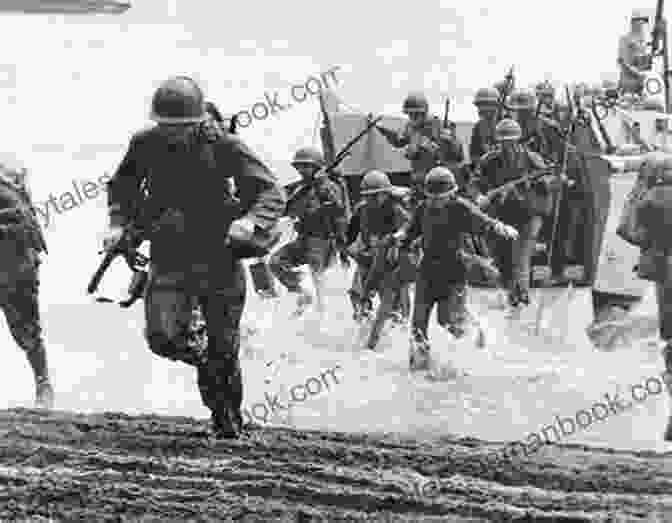The Development of Marine Corps Amphibious Doctrine, 1898-1941

4 out of 5
| Language | : | English |
| File size | : | 1873 KB |
| Text-to-Speech | : | Enabled |
| Enhanced typesetting | : | Enabled |
| Word Wise | : | Enabled |
| Print length | : | 21 pages |
| Lending | : | Enabled |
| Screen Reader | : | Supported |
The United States Marine Corps has a long and distinguished history of amphibious operations. From the landing at Veracruz in 1847 to the storming of Iwo Jima in 1945, Marines have played a vital role in projecting American power ashore. The development of Marine Corps amphibious doctrine has been a continuous process, shaped by the experiences of combat and the evolving nature of warfare.
The Early Years
The roots of Marine Corps amphibious doctrine can be traced to the late 19th century. In 1898, the Marines participated in the Spanish-American War, which saw the United States acquire overseas territories in the Caribbean and the Pacific. The war highlighted the need for a specialized force capable of conducting amphibious operations. In response, the Marine Corps established the Amphibious Brigade in 1903.
The Amphibious Brigade was a small force of Marines, sailors, and Army troops. It was designed to conduct raids and landings in support of naval operations. The brigade's first major test came in 1900, when it was deployed to China to suppress the Boxer Rebellion. The Marines conducted a successful amphibious landing at Taku Forts, which helped to open the way for the relief of Beijing.
The Interwar Period
The interwar period saw the Marine Corps continue to develop its amphibious capabilities. In 1921, the Marine Corps established the Fleet Marine Force (FMF). The FMF was a permanent force of Marines assigned to the Navy. It was designed to provide the Navy with a dedicated amphibious force capable of conducting a wide range of operations.
The FMF underwent a major reorganization in 1933. The brigade structure was replaced by a regimental structure. The FMF also began to receive new equipment, including landing craft and amphibious tractors. These new technologies gave the Marines the ability to conduct amphibious operations over greater distances and with greater firepower.
World War II
The outbreak of World War II in 1939 presented the Marine Corps with its greatest challenge to date. The Marines were called upon to conduct a series of amphibious landings in the Pacific theater. These landings included the assault on Guadalcanal in 1942, the invasion of Tarawa in 1943, and the Battle of Iwo Jima in 1945.
The Marines' amphibious landings in World War II were a major success. The Marines developed new tactics and techniques for conducting amphibious operations. They also learned the importance of close cooperation with the Navy and other branches of the military.
The Legacy of Marine Corps Amphibious Doctrine
The Marine Corps amphibious doctrine that was developed in the period from 1898 to 1941 had a profound impact on the conduct of World War II. The Marines' ability to conduct amphibious operations over greater distances and with greater firepower was a major factor in the Allied victory in the Pacific. The Marine Corps amphibious doctrine that was developed in this period remains the foundation of Marine amphibious operations today.
The development of Marine Corps amphibious doctrine has been a continuous process, shaped by the experiences of combat and the evolving nature of warfare. The Marines' amphibious doctrine has enabled them to project American power ashore for over a century. The Marine Corps amphibious doctrine is a vital part of the United States' national security strategy.



4 out of 5
| Language | : | English |
| File size | : | 1873 KB |
| Text-to-Speech | : | Enabled |
| Enhanced typesetting | : | Enabled |
| Word Wise | : | Enabled |
| Print length | : | 21 pages |
| Lending | : | Enabled |
| Screen Reader | : | Supported |
Do you want to contribute by writing guest posts on this blog?
Please contact us and send us a resume of previous articles that you have written.
 Top Book
Top Book Novel
Novel Fiction
Fiction Nonfiction
Nonfiction Literature
Literature Paperback
Paperback Hardcover
Hardcover E-book
E-book Audiobook
Audiobook Bestseller
Bestseller Classic
Classic Mystery
Mystery Thriller
Thriller Romance
Romance Fantasy
Fantasy Science Fiction
Science Fiction Biography
Biography Memoir
Memoir Autobiography
Autobiography Poetry
Poetry Drama
Drama Historical Fiction
Historical Fiction Self-help
Self-help Young Adult
Young Adult Childrens Books
Childrens Books Graphic Novel
Graphic Novel Anthology
Anthology Series
Series Encyclopedia
Encyclopedia Reference
Reference Guidebook
Guidebook Textbook
Textbook Workbook
Workbook Journal
Journal Diary
Diary Manuscript
Manuscript Folio
Folio Pulp Fiction
Pulp Fiction Short Stories
Short Stories Fairy Tales
Fairy Tales Fables
Fables Mythology
Mythology Philosophy
Philosophy Religion
Religion Spirituality
Spirituality Essays
Essays Critique
Critique Commentary
Commentary Glossary
Glossary Bibliography
Bibliography Index
Index Table of Contents
Table of Contents Preface
Preface Introduction
Introduction Foreword
Foreword Afterword
Afterword Appendices
Appendices Annotations
Annotations Footnotes
Footnotes Epilogue
Epilogue Prologue
Prologue Eric Foster
Eric Foster Malcolm Gauld
Malcolm Gauld Dylan Wiliam
Dylan Wiliam Creative Child
Creative Child Marie Kristin Hofmann
Marie Kristin Hofmann Cynthia Luhrs
Cynthia Luhrs David M Killoran
David M Killoran Casey Patch
Casey Patch Eugene Vodolazkin
Eugene Vodolazkin Esther Derby
Esther Derby Raann Clegg
Raann Clegg Akira Toriyama
Akira Toriyama Ross Davis
Ross Davis Royal Yarns
Royal Yarns R M Prioleau
R M Prioleau Elmore Hammes
Elmore Hammes Veronica Dinkins
Veronica Dinkins Merlin Mill
Merlin Mill Brenda Baker
Brenda Baker Kirsten Beyer
Kirsten Beyer
Light bulbAdvertise smarter! Our strategic ad space ensures maximum exposure. Reserve your spot today!

 Dwayne MitchellHow Hackers Break Into Your Facebook And Network And How To Protect Yourself
Dwayne MitchellHow Hackers Break Into Your Facebook And Network And How To Protect Yourself
 Spencer PowellUnveiling the Profound and Poetic World of Laurie Sheck's Black Series Poems:...
Spencer PowellUnveiling the Profound and Poetic World of Laurie Sheck's Black Series Poems:... Samuel WardFollow ·12.7k
Samuel WardFollow ·12.7k Chinua AchebeFollow ·15.5k
Chinua AchebeFollow ·15.5k Gus HayesFollow ·6.5k
Gus HayesFollow ·6.5k Finn CoxFollow ·8.6k
Finn CoxFollow ·8.6k Isaiah PriceFollow ·7.9k
Isaiah PriceFollow ·7.9k Jacob FosterFollow ·5.9k
Jacob FosterFollow ·5.9k Boris PasternakFollow ·13.9k
Boris PasternakFollow ·13.9k Henry HayesFollow ·5.3k
Henry HayesFollow ·5.3k

 Edwin Cox
Edwin CoxThe Great Deliverance Inspector Lynley: A Literary...
: In the realm of detective fiction,...

 Christian Carter
Christian CarterMetal Gear Solid Ground Zeroes Guide, Walkthrough, Tips,...
Metal Gear Solid...

 Branden Simmons
Branden SimmonsYellow Green: Not an Autobiography of Marcy Chen
Yellow Green:...

 Edward Reed
Edward ReedPurple Orchids: An Artistic Tale of Two Sisters in the...
Prologue: A Legacy Unveiled In the...

 Earl Williams
Earl WilliamsThe Evolving Housing Market Dynamics in Africa:...
The African housing market is a...

 William Faulkner
William FaulknerVoices In My Head: A Cerebral Symphony of Terror
In the labyrinthine...
4 out of 5
| Language | : | English |
| File size | : | 1873 KB |
| Text-to-Speech | : | Enabled |
| Enhanced typesetting | : | Enabled |
| Word Wise | : | Enabled |
| Print length | : | 21 pages |
| Lending | : | Enabled |
| Screen Reader | : | Supported |







